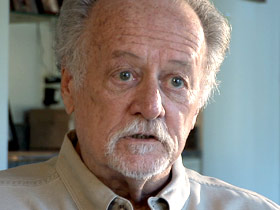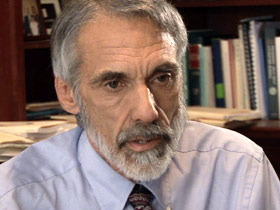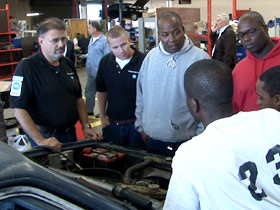In This Episode << SLIDE LEFT TO SEE ADDITIONAL SEGMENTS
Prisons for Profit
LUCKY SEVERSON, correspondent: In the United States there are more than two million citizens locked up behind razor wire and prison bars.
MARK MAUER: We lock up our citizens at far greater rates than any other industrialized nation or any other kind of nation in the world.
SEVERSON: Mark Mauer is the executive director of The Sentencing Project. He says that when it comes to lock ups, Louisiana is easily the toughest state in the nation.
MAUER: Louisiana has been at the top of the pack and just incarcerating people at rates that are just unimaginable any place else in the world.
SEVERSON: Richard Crane is the former chief counsel to the Louisiana Corrections Department. He says there was a push nationwide in the early 1980s to crack down on crime, and Louisiana took it seriously.
 RICHARD CRANE: You could always get votes by increasing sentences, and Louisiana more than any other state just went wild with that.
RICHARD CRANE: You could always get votes by increasing sentences, and Louisiana more than any other state just went wild with that.
SEVERSON: Today there are about 40,000 people behind bars in Louisiana. That’s one out of 86 adults. The prison population doubled in the last two decades, and the state prison system simply couldn’t keep up. So in the early 1990s the state gave local sheriffs an incentive to build their own prisons. Cindy Chang first reported about prisons-for-profit for the New Orleans Times-Picayune newspaper.
CINDY CHANG: In Louisiana, you’ve got all these prison entrepreneurs who are mostly local sheriffs who have built these prisons. The prisons function just like hotels—that they get a payment per person per day, and if they don’t keep the beds full they’re going to lose money.
SEVERSON: The Louisiana Secretary of Corrections Jimmy Le Blanc:
JIMMY LE BLANC: We didn’t have the means; we didn’t have the funding to accommodate building prisons. We didn’t have the money so that partnership, that cooperative endeavor of agreement together was a means to build additional prisons and have the beds that we needed to house prisoners.
 SEVERSON: It works this way: County or parish sheriffs get about $25 a day for inmates that would have otherwise ended up in state prisons. Some of that money goes to house and feed the prisoners. What’s left over goes to the underfunded sheriffs’ departments to use for much needed equipment and for manpower.
SEVERSON: It works this way: County or parish sheriffs get about $25 a day for inmates that would have otherwise ended up in state prisons. Some of that money goes to house and feed the prisoners. What’s left over goes to the underfunded sheriffs’ departments to use for much needed equipment and for manpower.
(to Crane): At one point that was a real good thing, because they didn’t have bulletproof vests; they had bad or old or used equipment.
CRANE: Well yes, you know, but is that the way to finance those things, you know by increasing sentences for the sole purpose of filling of up local jails. Is it ethical to incarcerate people for the sole purpose of making money?
SEVERSON: Burl Cain, warden of one of the country’s biggest prisons, Angola, says he has reservations about profiting from incarcerations.
WARDEN BURL CAIN: Yes, the profit motive bothers me when the profit motive is the motive to not provide the necessary essentials for the inmate. You feed them with a thimble, is a term I use. You try to cut them to 1800 calories a day, and so those things bother me, and they do that in the private sector more than the public, because they measure every little thing they give you. They’re cutting costs, they’re cutting dollars, and when they cut your quality of life by doing that, that’s wrong.
SEVERSON: The approximately $25.00 payment the sheriffs receive per inmate per day is less than a third of the average daily prison costs nationally, so there is very little or no money left over for rehab or education programs.
 CHANG: The term that’s often used is warehousing, that these people are just being warehoused during their sentence.
CHANG: The term that’s often used is warehousing, that these people are just being warehoused during their sentence.
MAUER: Going back to Philadelphia in the late eighteenth century, the Quakers and other religious reformers invented the penitentiary system from the word “penitence,” and their idea was you could take sinners, lock them in a prison cell, give them a Bible or have someone read the Bible to them and they would repent for their sins. So it was well-intended; it didn’t work out very well in practice. What’s sort of striking is that the model of incarceration has not changed that much 200 years later.
SEVERSON: One reason for Louisiana’s huge prison population is that the state leads the country in the percentage of inmates sentenced to life without parole. Life without parole for a young inmate who lives to be 72 years old can cost Louisiana taxpayers more than a million dollars.
 MAUER: More than one-in-ten people in prison in Louisiana are serving life without parole. The only way you can get out is getting a pardon from the governor, and that is something that rarely happens.
MAUER: More than one-in-ten people in prison in Louisiana are serving life without parole. The only way you can get out is getting a pardon from the governor, and that is something that rarely happens.
SEVERSON: Here at Angola, 97 percent of the over 5,000 inmates sentenced here will die here, no matter how young they were when they arrived.
LE BLANC: We probably have more than our share of lifers in Louisiana, and there are some nonviolent lifers, I mean, like three strikes and you’re out. We have quite a few of those, and those are the ones in my opinion that we need to be looking at.
CAIN: They should not necessarily be released, but they should have a hearing. They should be reviewed, and our situation and in a lot of states there’s no hearing.
SEVERSON: Louisiana did recently close down a prison and transferred the 900 inmates, who were in for lesser crimes, to Angola. It turned out to be a positive move, because the warden can use the lifers as mentors for the short-timers in the prison’s re-entry program.
 John Sheehan has served 26 years of his life-without-parole sentence for second-degree murder. He’s the lead mentor for automotive students. Heyward Jones, also in for life-without-parole for second-degree murder, is a social mentor.
John Sheehan has served 26 years of his life-without-parole sentence for second-degree murder. He’s the lead mentor for automotive students. Heyward Jones, also in for life-without-parole for second-degree murder, is a social mentor.
JOHN ANTHONY SHEEHAN: They can look at us different than other men that come in. You can have a church group that comes in and tells them one thing, but you have somebody like Heyward here and myself that have a life sentence that’s actually living here all the time, and tell them if they don’t do the right thing they can wind up here. Our message comes across a lot realer to them than what messages of other people do.
SEVERSON: But the re-entry program the warden is so proud of is not in the budget. The funding comes from the annual prison rodeo. The Louisiana Corrections Department, like those in other states, relies on churches to provide many re-entry programs. Still, Louisiana spends almost $700 million a year for corrections, money that could go toward other programs in a state that has some of the worst poverty and schools in the country.
LE BLANC: I’ll give you a good example. Our prison intake is 15,000 a year. Our high school drop out is 15,000 a year. I mean, that tells you the story of what is happening to us. They’re coming out of these schools and coming to prison.
CAIN: And you shouldn’t pay more for corrections than you do for education, but you are, and you’re keeping the wrong people in prison because you’re keeping everybody.
MAUER: I think it’s a very disturbing development that the world’s wealthiest society, the United States, a society that prides itself on its democratic traditions, is also the world’s leading imprisoner. There’s something fundamentally wrong, I think, with that picture.
SEVERSON: The picture is slowly changing, in part because states can no longer afford to imprison so many people. Legislatures are gradually reducing sentences for nonviolent crimes and turning more to rehabilitation programs. That includes Louisiana to a lesser degree, partly because of push-back from local sheriffs, whose budgets rely on keeping their jails as full as possible.
For Religion & Ethics NewsWeekly, I’m Lucky Severson in Angola, Louisiana.

